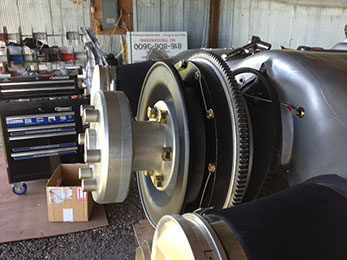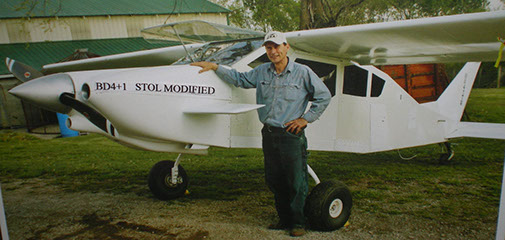

Good Morning,
I wanted to thank you and let you know how much difference your active balancer made on my O-360 engine. I had a definite but not horrible vibration at cruise speeds. After installing your active balancer, I was very pleased NOT to have my glareshield vibrating like crazy.
Another surprising plus was with my Stratus 2S. I use the ADAHARS feature for my iPad and Fore flight. The gyro functions displayed on the iPad are now super smooth!
Finally, I have to brag a bit...after installing the Balance Master, I entered the Oshkosh AirVenture Cup Race (2016) and took 3rd place in my class. I only beat 4th place by a short margin. I can't say for sure, but I bet it was the Balancer Master, as it gave me an extra 100RPM on the cruise flight.
Thx again!
Wes Parker
Lancair N360KL

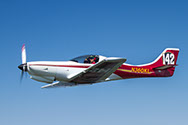
Just wanted to tell you how happy I am with my purchase of your product.
I do some prop testing for Catto Propellers & have had to balance several props dynamically to my engine at a cost of $225.00 each time, and that only provides balance at a much lower rpm than I run at due to me having a fixed pitch prop.
With your product, I noticed on take-off as the engine came up on the rpm's that it was much smother than before & continued to notice that through the whole range of prop speeds. So that you know, I'm the 2013 Northeast Advanced Aerobatic Champion, usually flying against much more capable airplanes with constant speed propellers, Which means I have to keep my engine spun up routinely to 3400 RPM to get the performance out of my mount.
Thru the years, I have had brackets & bulkheads constantly breaking due to vibration. It's nice to know now that regardless of how many props I decide to try, I now have "Active Dynamic Balance" that stays with the engine and no more need to spend money balancing every time I bolt a new prop on the front.
Thanks again for a product that ain't just hype. I will be telling my aerobatic buddies about you guys.
Tony Zorn
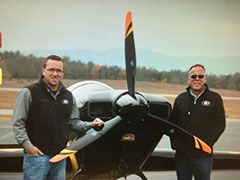
From: Rich Klarich <rklarich@gmail.com>
Got your call. I like it enough to hang onto it. My o-320 e2d Lycoming with 9:1 pistons and the cheap VIP isolators/mount rubbers are not smooth with a Sensinich 2 blade prop at idle or slowing to pattern speed.
Under 1900rpm is a bit rough. It was dynamically balanced fine at cruise. With the balance master, it feels the same.Feedback- the mount holes were not snug. They had maybe 1/16" wiggle room, and there may be larger lugs that are snug. I'm sure it is fine with the prop torqued on. The angle to the starter ring/flywheel and diameter of the mercury ring meant no traditional dynamic bolt/nut/washer combos could be used- it would bear on the mercury ring.
Because of items behind the flywheel like the starter, the bolt heads are aft, and nuts/washers/shank face forward. I won't put weights on the spinner flanges, so it's either balance master OR flywheel weights.
Since it acts as well as the dynamic balance weight, I kept it. I will eventually go to a Catto 2 blade, and those are smoother than the metal props.
I love the concept. It works at cruise RPMs.
Rich
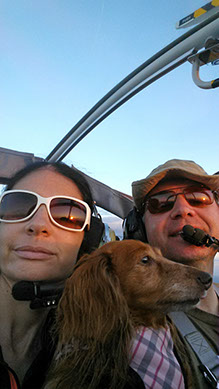
Hi Chris
Thank you for checking on my Dynamic Balance Master. I have the Master balance installed on my Cozy4 aircraft with a Lycoming IO-360 engine and a wooden 3-blade performance propeller. The propeller, from time to time, gets a notch from the dirt on the runway and needs patching. The patching on any blade would put the propeller out of balance. In the past, the propeller needed to be rebalanced statically and dynamically by adding weight drilled into the propeller center hub; this would make the propeller weaker. after installing the Balance Master on the engine ring gear, any repair patching to the propeller blades is finished with smooth sanding and clear paint finish, and no need to balance it again. The Balance Master takes care of the minor shift of the weight and smooths the propeller very well. Also, I noticed that during checking the engine magnetos, when running the engine on one Magneto, the engine rpm drops about 80 RPMs, and there was slight roughness in the motor. The balance master takes care of this roughness the engine runs smooth.
The Balance Master maintained smoothness and protected the engine and the propeller from vibration. Vibration is the engine's worst enemy. The Balance Master was the best enhancement that I have installed to protect the engine. The installation was easy, and it did fit perfectly on the engine ring gear holes. I have attached photos showing the Balance Master on the engine IO-360 ring gear.
Please use my photos and testimony for your product. I think you should advertise it better and explain its benefits in more clear articles in the EAA sport aviation magazine, kit plane magazine, and Plan and pilot magazine.
Regards
Thank you
Khalid Shuwayhat
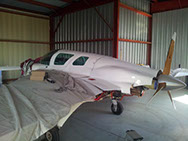
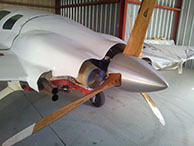

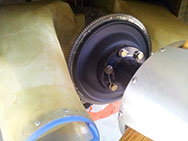

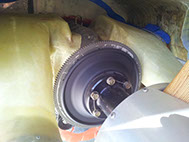
Chris,
Nice to talk to you this morning, and thanks for taking the time to answer my questions. Here are a few shots of my "magic carpet ride."
I installed the Lycoming Balance Master on this Starduster SA-100 open-cockpit, single-seat biplane, powered by a 140hp Lycoming O-290-D2-B, behind a Warnke wood prop. That was in Sept. 2015 and about 100 worry-free hours ago. The disk, inspected twice a year, along with the prop, looks like it did the day it was installed. No sweat there.
After installing the Balance Master, there was a noticeable reduction of engine vibration on my biplane, readily seen in the brace wires, at any given power setting. In flight, the whole aircraft feels even better, right through the seat of my pants. The wear on the prop from my graveled homeport, and any subsequent dressing of the prop, is not an issue balance-wise, so long as the Balance Master goes back on the airplane.
Until I am running an electric motor in my biplane, your product will remain on the Lycoming and my Starduster, helping to smooth the ride. Great product and worth every cent.
Cheers,
Bud Liberatore,
Eagle Point, Oregon
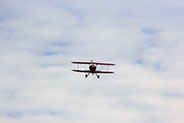
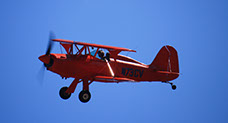

Since the above link to my Balance Master results is no longer active, and because I've had several folks ask, here is my experience and comments from 2014, for what it's worth, with some recent edits:
I have completed a test of the Balance Master prop balance product on my AFP vertical injection, ECI 360, with Whirlwind RV200 prop, on my RV-7A with 380 hours.
First, thanks to Roger Lee, and A.J. Pawloski, for their great help in conducting this test. The Balance Master product may be obtained from Mark at Checkered Flag Restorations (http://www.checkeredflagresto rations...tributors.html).
The following results were done with ACES equipment and prop at takeoff pitch (ie. fine pitch with RPMs controlled by the throttle).
First, we completed a new conventional balance just prior to installing the Balance Master. The results:
Without conventional balance weights at 2300 rpm: 0.17 ips.
After a new conventional balance at 2300 rpm: 0.12 ips.
Next, we removed the conventional balance weights and installed the Balance Master.
The results:
2300 rpm: 0.11 ips.
2000 rpm: 0.11 ips.
1500 rpm: 0.11 ips.
1000 rpm: 0.11 ips.
Results and Comments:
1. The cost of the Balance Master, at $350 (not including costs associated with prop removal and re-installation), was over twice what it cost me to get a conventional balance ($125).
2. Unlike a conventional balance, installation of the Balance Master requires removal and re-installation of the propeller.
3. Except for prop removal and installation, installation of the Balance Master was very easy. It fits directly on the front face of the ring gear flywheel. Existing propeller bolts were able to be reused.
4. Since I have a lightweight propeller, the added weight of the Balance Master (about 1.3 lbs) was not a concern for me.
5. Looking only at the vibration numbers, the Balance Master (0.11 ips) did not appear to be significantly better than a conventional balance (0.12 ips).
6. Notice the consistent vibration numbers at each rpm. This is one of the reported advantages of the Balance Master.
7. Unlike a conventional balance, the Balance Master should not require a re-balance every few years.
8. Though not listed here, the differences in vibration levels at various rpm's with the conventional balance was no more than 0.03 ips. I don't claim to be able to 'feel' differences this small; however, as soon as I started the engine with the Balance Master product, I did 'intuitively believe' that the prop/engine was smoother. Attribute that to wishful thinking, if you will.
9. I was never completely confident in these test numbers. I would like to see results from additional testing.
Should I keep the Balance Master or return to the conventional method? I look forward to your comments.
About a month later, I returned the Balance Master and completed another conventional balance with a different person doing the balancing. The results, at 2300 rpm, were:
Without any balance weights, 0.66 ips
After conventional balance, 0.02 ips.
Roger, 7A, N374RS, Tucson
Hey Chris,
Want to tell you how happy I am with the latest Balance Master that I got from you. Put it on my swamp monster (modified woody Pusher). I changed the prop from a wood Sensenich to a plastic prop that would not absorb the engine pulses from the little C-90 . Was getting beat to death till putting your product on made the prop all I was hoping for! As with the one I put on my aerobatic mount, I was very pleased. As I told you on the phone....ain't much nowadays you can buy that will make an immediate difference in the seat of the plane. Yours does. Most companies that claim the ability to do that are selling snake oil.
Again,
Thanks,
Tony Zorn

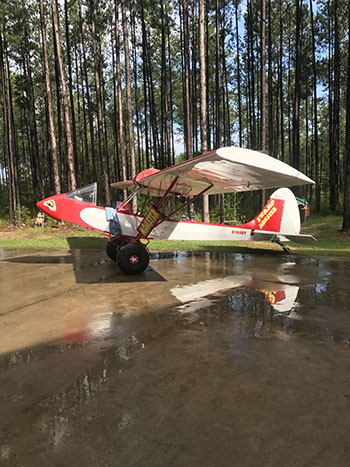
Chris,
As I mentioned on the phone, I am extremely satisfied with the Lycoming engine balancer I bought from you 4 years ago. My engine (IO-360 with angle valves) is factory rated at 200 Hp. I designed and replaced the stock cross-over with 4 into 1 tuned headers which ups the Hp around 7%. I also added cold air direct induction, which should conservatively add another 5% Hp. So I'm pumping out somewhere between 220- 225 Hp total.
I had the same model engine (without the power upgrades) on my '73 Cardinal RG a few years back with first an (approved) McCauly C.S. 2-blade Aluminum prop. It had a very noticeable harmonic vibration between 2000 & 2200 RPM. I switched to an (approved) Hartzel C.S. 3 blade Aluminum “Top Prop”. That prop did run a bit smoother in the same RPM range. But it stayed with the plane when I sold it.
As you know, Hartzel warns against using their props on anything except those approved by them for that specific prop/engine/airframe combination. That sets a very high bar for most home-built aircraft. I did find a Hartzel 2-blade aluminum prop (new condition) that had been approved for use on an R.V. plane with my same model engine. I don't know how much the airframe contributes to harmonic vibration, but it vibrated noticeably in that same RPM range.
That's when I decided to have the prop & engine balanced on my plane (BD-4). My research said that with most balancing methods, you have to pick one RPM to balance at. It seemed like a lot of money ($350 +/-) to balance each new prop you try and at only one RPM!
Then I ran across the Balancemasters.com website. You claimed that your engine/prop balancer would automatically re-balance at any RPM and with any prop. I may have been “born in a barn,” but NOT yesterday. It all sounded too good to be true, but hey, it only cost about the same as a single dynamic balance (which I would do after the Balance master failed)
Long story shortened...It didn't fail to run smoothly at any and all RPMs between idle and red-line (2700 rpm). I then switched to a wood core/composite Prince F.P. Prop for a while. Then I went to a Whirlwind Composite 2-blade 74HRT C.S. Prop, looking for improved airflow through my very tight cowling (which the previous props failed to improve).
In general, 4 cly Lycs are notorious (even in their own literature) for vibrations between 2000-2300 and above 2600 RPMs. During take off I want 2700 for longer than a couple of minutes, especially in mountainous terrain and without life-limiting vibration. And for an economy cruise, something between 2000-2300 is really nice. With your Balance master ring, I can choose any RPM on any of the 3 (very different) props I tested without noticeable vibration! Oh, and did I mention how easy the installation is...easy peasy!! Thanks for knocking a home run right out of the park!!! Every aircraft engine needs one...I give it 5 stars (times 2).
A very satisfied customer (one who almost never writes reviews)
Timothy (Mac) McGinnis
PS. I know this “book” is too long for advertisements, but I just had to share the whole story with you. So feel free to edit to your heart's content and publish where you see fit. I'm also really interested in your landing gear balancers. Please send any literature and prices for (2) 6” main wheels. Do you have one to fit a 5” nose wheel with a forked attachment nose strut?
